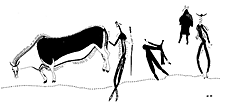Jean Clottes, the French cave art expert, has written several books, including one on Chauvet Cave and one entitled Cave Art, an imposing coffee-table sized book with beautiful full-page color illustrations. However, it’s curious that a book with the title Cave Art is really about only three caves in France:
Chauvet, (35,000 – 22,000 years ago)
Lascaux, (22,000 – 17,000 years ago) and
Niaux, (from 11,000 years ago).
That list may be understandable in that the author is French and most familiar with French cave art in these areas. However it’s misleading and perpetuates a misconception.
At first glance, it seems to be a glaring omission of Spain’s notable cave art, especially that of Altamira, El Castillo, and other sites. Altamira cave paintings are so impressive that the area was designated a UNESCO World Heritage site in 1985. One section of the ceiling of Altamira cave is shown in the photo (left).
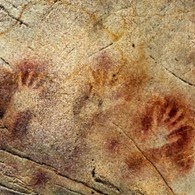
El Castillo Cave (Spain) contains the oldest cave paintings known in Western Europe, with a red disk dated to 40,800 years old – perhaps the work of our Neanderthal cousins. That’s at least 8,000 years older than the oldest dates from Chauvet Cave in France. The photo on the right shows negative hand prints and a red dot visible in the lower left – the famous disk.
But Clottes omits more than Spain. He leaves out the rest of the world!
In his introduction to Cave Art, Clottes defines art as “the result of the projection of a strong mental image on the world, in order to interpret and transform reality, and recreate it in a material form.” Thus, he says, older marks, like circles, spirals, and crossed lines cannot be considered art. I wonder if he’s strolled through a modern art collection lately.
He dismisses African and Australian art as hard to date and therefore not worth considering. He omits Indian and Indonesian cave art entirely. Even Eastern European finds like Pestera Coliboaia cave art in Romania, the oldest cave art in Central Europe, doesn’t merit a mention.
Then he moves on without apology: “So while we can be sure that European Paleolithic art was not modern man’s first artistic endeavor, it is without a doubt the best known and best researched form of ancient art. This is due in part to complex economic and historical factors – Europe is rich, and its Paleolithic art has been studied for well over a century – but also, and perhaps especially, because its spectacular imagery still appeals to our modern sensibilities.”
That’s the argument, in a nutshell. And its endless repetition helps perpetuate the erroneous idea that art originated in Europe because, well, you know, Europe is the richest and the best. And by Europe, he means France.
The truth is that French cave art is probably the most extensively studied but not the oldest or even the most sophisticated cave art in the world. Instead, it shares many themes with other cave art sites around the world and fits easily into the world cave art collection.
Consider these examples:
Maros Cave, Sulawesi Island, Indonesia

Currently, cave art found in Sulawesi Island, Indonesia has been dated to over 40,000 years old. (If you’re keeping score, that’s competing with Europe’s oldest.) The red ochre paintings were dated by examining the calcite deposits that had formed on top of the drawings, on the theory that the paintings had to be at least as old as the material that covered them. Paintings include human figures, wild animals, and many hand stencils, one of which, when tested, was found to be 39,900 years old. Next to that print is a drawing of a pig, found to be 35,400 years old. They are currently the earliest known handprint and the earliest known drawing of an animal. Interestingly, scholars have known about these drawings since the 1950’s, but the images were dismissed as being no more than 12,000 years old because that was the date they had assigned to human migration to the island. This sort of constricted thinking, in which the data must fit the model, is a continuing problem in archaeology. The image in the photo (left) is fragmented by deposits laid down on top of it. The animal is facing right. Its narrow nose is fairly easy to spot. Its little hind legs are also easy to see. A stenciled hand print is visible below the pig’s shoulder.
Some cave paintings in Arnhem Land feature the Genyornis, a giant emu-like bird considered extinct for over 40,000 years. Rock shelters in the Northern Territory provided homes for people as far past as 50,000 years ago. They left behind drawings of fish (photo, right), turtles, possums, and wallabies, but few images have been dated. Geologist Bruno David noted, “We don’t have the dated art itself, but we’ve found the tools that were used to make the art. For that reason, we rightfully assume that Australia has pigment art going back to when people first came here which is close to 50,000 years ago.”
The charcoal drawings at Nwarla Gabarnmang have been dated to 28,000 years old. A drawing of the Rainbow Serpent in the Northern Territory was found to be 23,000 years old. All of these would then be older than the famous paintings in Lascaux Cave in France.
One of the problems with dating Australian aboriginal rock art in some areas is the practice of renewing sacred drawings: painting over images to increase their power. While the practice is completely understandable, it makes dating the images very difficult.
India
Evidence found in the Bhimbetka rock shelters in Madhya Pradesh, India indicate they were inhabited by hominins for over 300,000 years; some experts claim more like 700,000 years. That would make the most ancient residents Homo erectus. Some cupules and an engraving discovered in the 1990s were dated to 290,000 years old!
This adds more evidence to the argument that art came before modern humans.
The earliest Bhimbetka paintings known at this time have been dated to 30,000 years old (Photo, left). That’s close to the dates for Chauvet Cave, the oldest rock art site in France.
Pedra Furada, the controversial early site in Brazil, has been dated to between 32,000 and 48,000 years old. Some experts claim 60,000 years old. Rock art there, including images of animals, has been dated to at least 12,000 years old. The image on the right may show a mother deer and baby, as well as a smaller figure, perhaps a frog or turtle.
Cueva de las Manos in Patagonia (Argentina side) has handprints dated to 13,000 years ago.
Mongolia
Khoit Tsenkheriin cave in Mongolia has paintings dating back to the Upper Paleolithic Period (20,000 – 15,000 years ago). In one corner of the cave, overlapping symbols and animals painted on the ceiling and wall include lions, elephants, sheep, ibexes, ostriches, and antelopes, camels. Often, the animals’ horns, humps, and necks are exaggerated, just as they are in the more well-known cave art of Lascaux, roughly its contemporary.
Commonality
Even more interesting than the range of ancient rock art is the number of curious commonalities.
Stylized animals
Often the creatures painted on cave walls are not animals commonly hunted for food but fearsome, powerful beasts. Typically they are painted in profile, with exaggerated but recognizable features. The head, horns, neck and shoulder sometimes stand in for the whole animal. The wooly rhino from Chauvet Cave (left) is remarkably similar to the painting from Pestera Coliboaia cave in Romania (right).
The bison paintings are also similar. The painting on the left is from Chauvet Cave, France, while the figure on the  right is from Coliboaia Cave, Romania. Interestingly, both images give a sense of movement in the front legs. The Romania image uses the natural curve of the stone. The French image uses a kind of animation effect where multiple front and back legs give the sense of motion.
right is from Coliboaia Cave, Romania. Interestingly, both images give a sense of movement in the front legs. The Romania image uses the natural curve of the stone. The French image uses a kind of animation effect where multiple front and back legs give the sense of motion.
The hand stencil
The most universal image in cave art is the hand print and the negative hand stencil. The print was made by applying pigment to the hand and pressing the hand against the stone. The stencil was made by placing a hand on the rock and blowing pigment over it, leaving the negative image of hand. In many sites, both techniques are employed.
These positive and negative hand prints appear all over the world, including sites in India, Borneo, Australia, Africa, Europe, North and South America.
Here is a sampling from Cueva de las Manos (Patagonia, Argentina – far left), Sulawesi (Indonesia second from left), and Canyon de  Chelley, Navaho Nation (third from left)
Chelley, Navaho Nation (third from left)
The panel of hands and dots on the lower left is from El Castillo Cave (Spain). The ones on the right are from Indonesia. The two panels are about the same age: 37,000 years old.
For ancient people, a handprint might have been a registry: “I was here,” an ancient form of marking (or “tagging”). Several hand prints might mark the presence of a group. Multiple prints in the same spot might increase the energy of that place and reinforce the power of the group. The hand print proclaims participation, even if it is with the rock surface itself, just as you might touch a sacred relic or a photo of a long-lost friend or relative.
The handprint is still very important in our culture. In some hospitals, a baby’s hand and foot prints are recorded immediately after birth. As they grow up, children love putting their handprints on – everything! Maybe your toddlers put handprints along your clean wall because the desire to mark a place with their hands is embedded in them. It’s part of being human.
In a local high school I noticed a large paper sign covered with hand prints, apparently from students who had agreed not to drink and drive after their senior prom. The photo of chalk hand prints on a blackboard (left) brings out the sense of energy that the collective prints generate.
If you’re a famous movie star, you get to leave your hand and foot prints on the Hollywood Walk of Fame by the Chinese Theater. Then you’ve really made your mark. (See photo, right)
Rather than perpetuating the myth of art beginning in Europe, we should be celebrating the wealth of our heritage as humans all over the world. We are, as far as we know, the only species to make art (and orchestral music and space flight). We need to keep exploring rock art sites, especially in areas that are currently being lost to rising ocean levels, so we can learn as much as possible about these treasures.
Sources and interesting reading:
“Aboriginal rock art – how old is it actually?” Ask an Expert. ABC Science, Brad Pillans and Keith Fifield’s talk about dating cave art. http://www.abc.net.au/science/articles/2014/10/09/4102916.htm.
“Ancient Art of Kakadu,” Australia.com, http://www.australia.com/en/places/kakadu/nt-rock-art.html
Balter, Michael. “Romanian Cave May Boast Central Europe’s Oldest Cave Art,” Science Magazine, http://news.sciencemag.org/erope/2010/06/romanian-cave-may-boast-central-europes-oldest-cave-art
Bryner, Jeanna. “In Photos: The World’s Oldest Cave Art,” Live Science, http://www.livescience.com/48199-world-oldest-cave-art-photos.html/
“Cave of Altamira and Paleolithic Cave Art of Northern Spain,” United Nations Educational, Scientific, and Cultural Organization (UNESCO), World Heritage List, http://whc.unesco.org/en/list/310/
“Cave painting,” Wikipedia (a very good article), https://en.wikipedia.org/wiki/Cave-painting
Clottes, Jean. Cave Art. London: Phaidon Press, 2008.
Clottes, Jean. “Paleolithic Cave Art in France,” The Bradshaw Foundation, http://www.badshawfoundation.com/clottes
“Cueva de las Manos: A Cultural Heritage of Humanity,” http://www.patagonia.com.ar/circuits/587E_Cueva+de+las+Manos
“El Castillo Cave Paintings” Encyclopedia of Stone Age Art. Visual Arts Cork, http://www.visual-arts-cork.com/prehistoric/castillo-cave-paintings.htm/
Ghosh, Pallab, Science Correspondent, “Cave paintings change ideas about the origin of art,” BBC News, 8 October 2014, http://www.bbc.com/news/science-environment-29415716/
“Hand Paintings: Hand Paintings in Rock Art around the World” The Bradshaw Foundation, http://www.bradshawfoundation.com/hands/
“Handprints on blackboard” photo, celestecotaphotography.com
“History of India,” Wikipedia. http://en.wikipedia.org/History_of_India/
“Khoit Tsenkheriin cave,” Mongolian Cave Research Association, http://www.mongoliancave.com/CaveEng/2
“Madhya Pradesh,” Wikipedia, https://en.wikipedia.org/wiki/Madhya_Pradesh/
“Oldest Rock Art,” Encyclopedia of Stone Age Art. http://www.visual.art.cork.com/prehistoric/rock-art.htm/
“Pestera Coliboiaia – Coliboaia Cave Rock Art,” Central Europe’s oldest cave paintings discovered at Coliboaia Cave, Don’s Maps (a fabulous source) http://www.donsmaps.com/index.html#sites
“Prehistoric Hand Stencils,” Encyclopedia of Stone Age Art, Visual Arts Cork, http://www.visual-arts-cork.com/prehistoric/hand-stencils-rock-art.htm/
Thompson, Helen, “Rock (Art) of Ages: Indonesian Cave Paintings are 40,000 Years Old,” Smithsonian.com, http://www.smithsonianmag.com/science-nature/rockart-ages-indonesian-cave-paintings-are-40,000-years-old-180952970/?no-ist
Vergano, Dan. “Cave Paintings in Indonesia Redraw Picture of Earliest Art,” National Geographic News, http://news. Nationalgeographic.com/news/2014/10/141008-cave-art-sulawesi-hand-science/
Vergano, Dan. “Q&A: Cave Art Older, More Widespread than Thought, Archaeologist Says,” National Geographic News, http://news.nationalgeographic.com/news/2014/10/141010-cave-art-indonesia-alistair-pike-questions-science/
Wilford, John Noble. “Cave Paintings in Indonesia May Be among the Oldest Known,” The New York Times, 8 October 2014, http://www.nytimes.com/2014/10/09/science/ancient-indonesian-find-may-ival-oldest-known-cave-art.html/






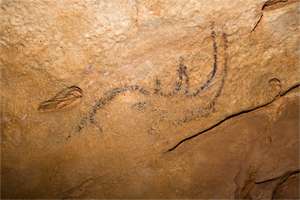






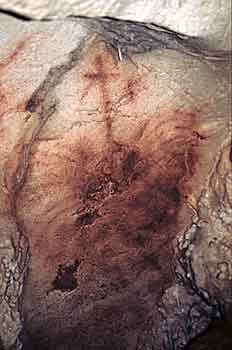 mber also contains a striking panel of red dots made by coating a hand with red ochre and pressing it against the wall. To the right of the red dots is a section with red dots and lines that seem to pour out from a central fissure in the rock. The cruciform symbol appears several times on the panel (photo, left).
mber also contains a striking panel of red dots made by coating a hand with red ochre and pressing it against the wall. To the right of the red dots is a section with red dots and lines that seem to pour out from a central fissure in the rock. The cruciform symbol appears several times on the panel (photo, left).
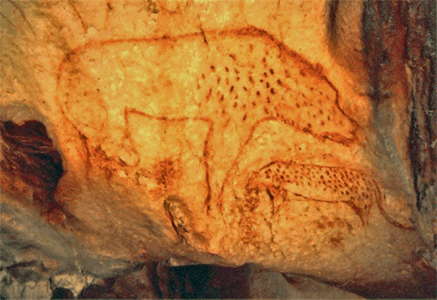
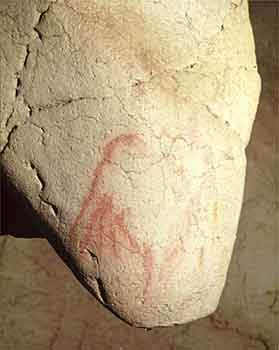
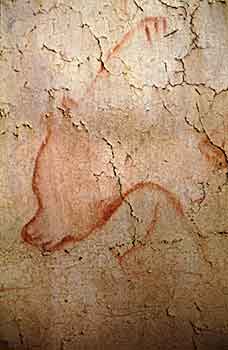






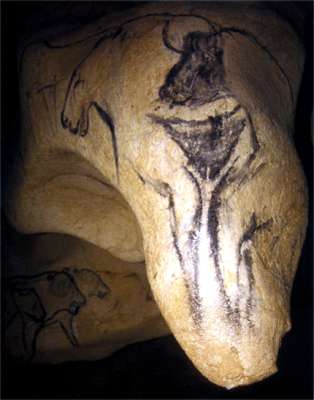 most enigmatic part of the End Chamber, and indeed the whole cave, is the V-shaped rock formation mentioned above. It’s painted with the head of a male bison and the pubic triangle and leg of a woman that seems to fade into a lioness painted on the flat section (See photo, left). It’s often called the Sorcerer. Though its function is unknown, it certainly encourages comparisons with the androgynous Spirit Master of western US cave art. Yahwera, as the spirit master is known, keeps all the animals inside the earth and then releases them through a crack or crevice. People mark the location of the portal to the Spirit Master’s cave with hand prints and drawings on the rock.
most enigmatic part of the End Chamber, and indeed the whole cave, is the V-shaped rock formation mentioned above. It’s painted with the head of a male bison and the pubic triangle and leg of a woman that seems to fade into a lioness painted on the flat section (See photo, left). It’s often called the Sorcerer. Though its function is unknown, it certainly encourages comparisons with the androgynous Spirit Master of western US cave art. Yahwera, as the spirit master is known, keeps all the animals inside the earth and then releases them through a crack or crevice. People mark the location of the portal to the Spirit Master’s cave with hand prints and drawings on the rock.





